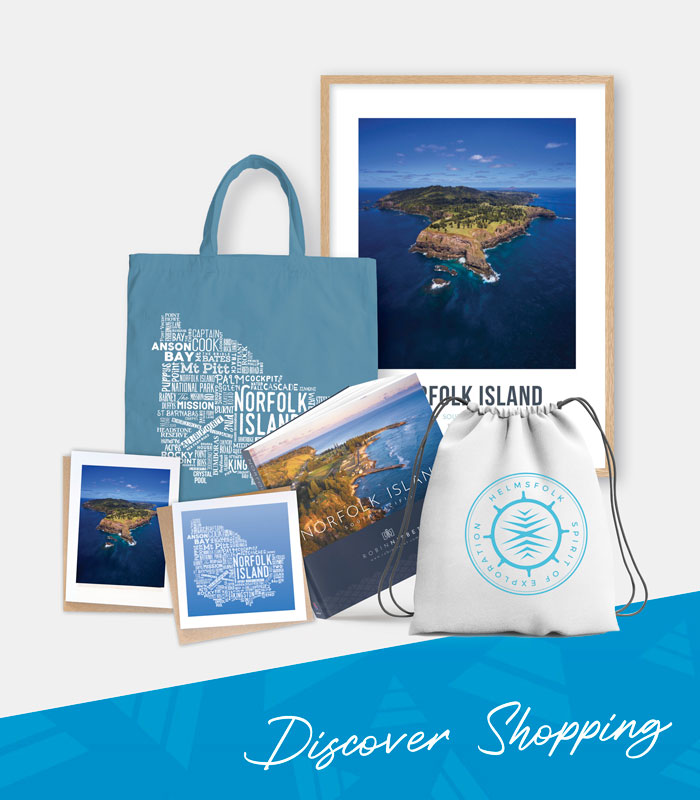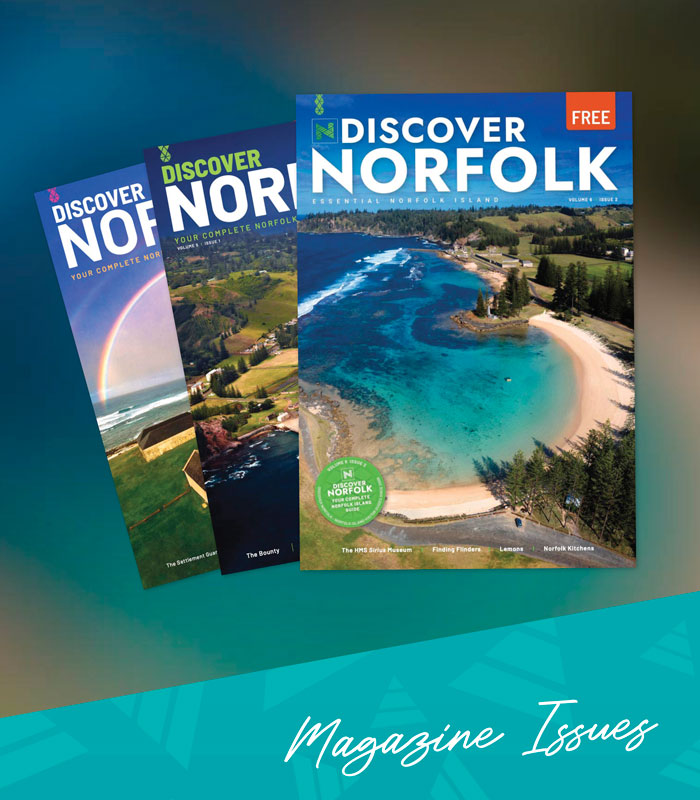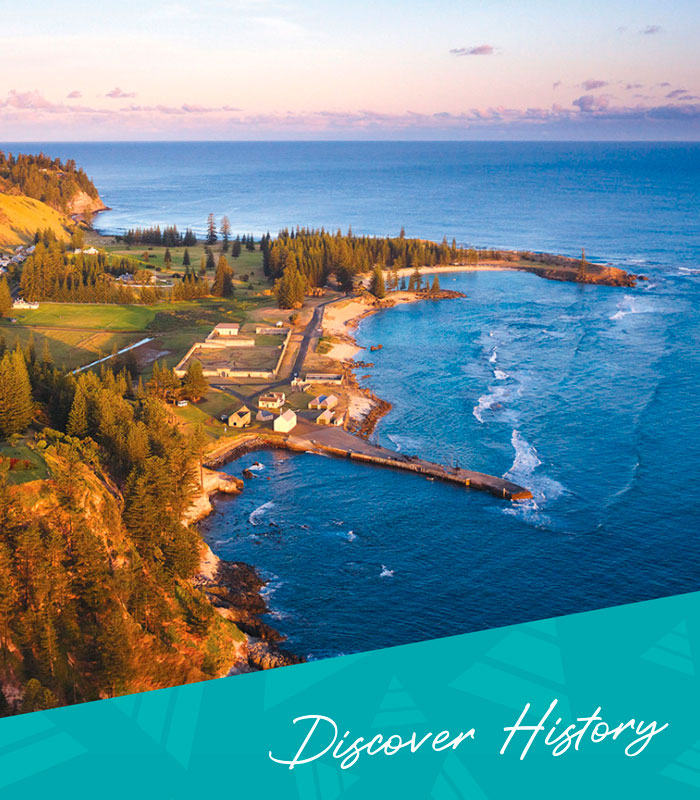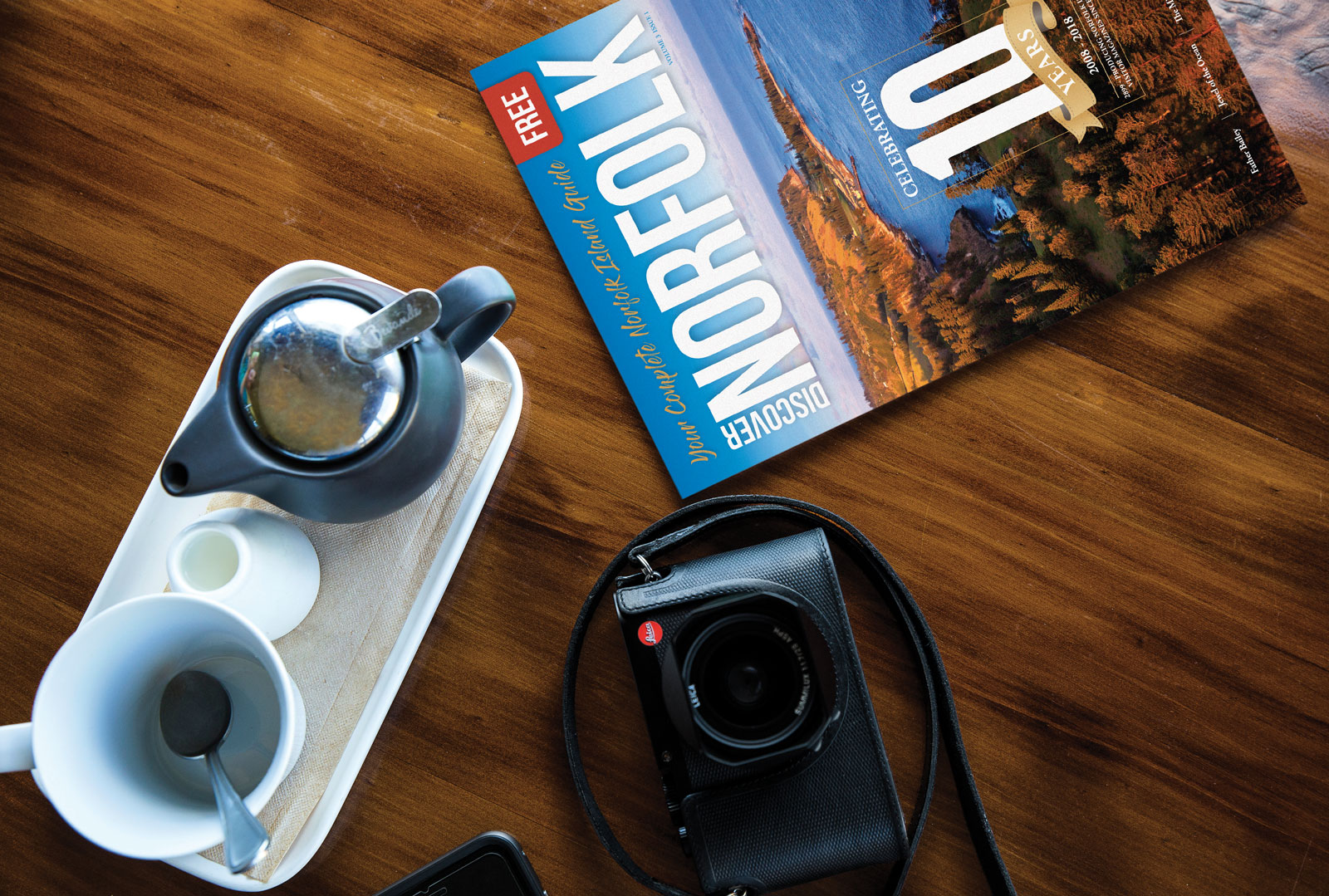Home » All Articles » Pushing the envelope since 1947
Pushing the envelope since 1947

Pushing the envelope since 1947: Highlights from Norfolk Island’s rich philatelic history.
Next time you check your letterbox, keep an eye out for a little piece of Norfolk Island’s maritime story gracing the top corner of your envelope. The Norfolk Island Museum is proud to have two of our First Fleet ship models featured in an Australia Post July stamp issue.
The Maritime Models issue will be joining the Norfolk Island Museum Trust (NIMT) collection as the most recent addition to a unique philatelic record that spans back to 1947.
The NIMT collection contains hundreds of postmarked and stamped envelopes, known as first day covers (FDCs), as well as single stamps, pre-stamped envelopes and even original philatelic artworks. Topics depicted on Norfolk’s stamps include everything from fungi to the Queen’s 1974 visit with the pictorial record for this small Pacific island having delighted collectors for decades.
Two key collectors are responsible for the majority of the represented items in the NIMT collection. Ian Kenny was a New Zealander who moved to Norfolk in the early 1960s. His collection of FDCs spans 1966-1990 and is kindly on loan from the Kenny family.
Comparatively, Robert Varman lived on Island for a shorter period but boasts a more diverse collection including stamp souvenirs, two stamp books and FDCs. Varman worked as the Commonwealth archaeologist from 1981 to 1990 excavating historical sites at Kingston, now a World Heritage Site. Both men purchased and compiled their philatelic collections from the Norfolk Island Philatelic Bureau and provide great examples of how Norfolk Island’s postage stamps were treasured, collected, enjoyed and displayed.
Stamps had a very brief appearance during Norfolk Island’s second British settlement, 1825-1855, a harsh penal colony. Van Diemen’s Land had sent 16 pounds worth of stamps to the Island in 1853 only for the shipment to be hijacked during the voyage by escaping convicts. Although the fate of the convicts was never confirmed, a small number of these stamps taken from the ship The Lady Franklin were recovered and are now highly collectible. A second consignment successfully made it to Norfolk Island, but were only in use 14 months before the closure of the Penal Settlement.
In 1856 the fourth settlement of Norfolk Island began with the arrival of the Pitcairn Islanders on the 8th June. From this time onward, the community used NSW stamps or organized for passing sea captains to post letters in the next port of call. In 1914 Norfolk Island became a territory of the Commonwealth and used Commonwealth stamps for the next twenty-three years.
1937 was the pivotal year where it was decided Norfolk Island was to have its own stamps. An image of Ball Bay, photographed by local Roy Bell, was agreed on and the stamps were printed by the Commonwealth Note Printing Branch. Both the Varman and Kenny collections contain examples of these early Ball Bay stamps, however a close eye is needed to understand rarity.
Following the 1937 printing WWII intervened and the stamps were never sent. At the end of the war, efforts were revived and new stamps were printed using the same Ball Bay design. The only way to differentiate between the two issues is the 1937 issue had eleven perforation holes per 25mm whereas the 1947 issue has fourteen. A small number of the original 1937 stamps were stolen from the secure store in the Note Printing Branch and are available in the philatelic market. Both the Kenny and Varman examples are from the 1947 issue which was officially released on 10th June 1947. In the first year, the issue earnt £24,355.00 in sales, a large sum for Norfolk Island in the 1940s. The 1947 issue is considered a hallmark for any serious collector of Norfolk philatelic material.
Once Norfolk Island introduced its own stamps there was increasing demand from overseas collectors for both these and FDCs. Kenny’s 1947 FDC shows some envelopes included a rudimentary cachet, or artwork, showing a pine tree and Phillip Island in the background. These artworks were to become more ornate in later years. The demand increased to the point where reprints of the Ball Bay stamp were necessary for some of the values. Due to insufficient stamp stocks and a change in postage rates it was decided that a new issue would be released in 1953.
Following a different commemorative issue in 1956, the Ball Bay design returned again in 1959 in new colours, green (3 shillings) and blue (2 shillings). The words ‘Norfolk Island’ and ‘Australia’ sharing space on one stamp is not a modern phenomenon with the first example actually occurring in 1959. The Norfolk Island stamp appropriated the design released by the Australian GPO in the same year to commemorate 150 years of the Post Office in Australia. Norfolk’s version of the stamp had the words ‘Norfolk Island’ printed in red alongside the original ‘Australia’. Norfolk Island’s version was also more expensive with five pence printed over Australia’s original four pence value.
A new definitive issue was released in 1960 and by 1961 it was noted that stamp sales were becoming an important source of revenue for the Island. H. J. Powell notes the two financial years prior to 1960 made £45,000 which would roughly equate to £875,424.00 (UK) today. Demand from collectors continued and over the next few years Norfolk continued to release a small number of stamps annually. In 1966 Norfolk Island, along with the rest of Australia, introduced decimal currency. The 1962 definitive issue of 12 stamps was overprinted to provide new values on the existing stamps as shown in the two examples of the Hibiscus insularis stamp from the Varman collection.
The stamps were initially printed with a small silver panel obliterating the old value and then the new currency value printed on top. This was carried out with some difficulty by the Note Printing Branch of the Mint. Discrepancies in the overprinting process meant that collectors enjoyed acquiring both the big and small versions of these overprints as shown in Varman’s collection.
Rather like the variation in the 1962 decimal reprints, any variation, mistake or recalled stamp became attractive to collectors. The 90c stamp from the 1986 Bicentennial of Norfolk Island series is deliberately collected twice in Varman’s stamp book. Although they look identical the first issue of Governor Phillip meeting the Home Secretary stamp has a misspelling that rendered ‘Secretary’ to ‘Society’. The spelling error made the ‘Society’ stamp a must-have for any serious philatelic collector of Norfolk Island stamps.
In 1979, Norfolk Island became a self-governing territory. This became a pivotal moment for Norfolk Island’s Philatelic Bureau as their stamp products were now considered to be issued by an independent postal administration. While some stamps were based on photographs, the Norfolk Island Philatelic Bureau also commissioned artists.
The NIMT collection includes five examples of original philatelic artworks by David Hopkins which were used in pre-stamped envelopes (PSE). Three from the 1987 Commandants and two from the Pitcairners of Norfolk Island series of the same year. Varman’s collection holds five of the PSE from the Pitcairners series including the George Henry Parkin Christian envelope that bears Hopkins’ depiction of early whaling held in the collection.
The Bureau grew to include twelve philatelic staff who selected designs and printers, commissioned artists and oversaw the worldwide distribution of stamps, FDCs and newsletters. As in the Territory days, the Philatelic department made huge profits from its philatelic activities and was interlinked with the booming tourist market in the 1980s. Stamps didn’t just have a practical use, they could also become tourist souvenirs and advertisements for the Island. The Philatelic Bureau did not just manage requests regarding stamp collecting but also unique postmarks. When a postage stamp is marked in the mail it is ‘cancelled’, these cancellation marks became another collectable aspect with both the Kenny and Varman collections testifying that cancellation mark were sometimes as varied and artistic as the envelope and stamp.
The Island also pushed the envelope in regards to design, moving away from the traditional postage stamp shapes, and releasing three separate issues of stamps in the distinctive shape of Norfolk Island from 1974. The last example made is the 1978 Commemorative Issue celebrating the Island’s 50th Anniversary of the Scouts. These irregular shaped stamps were die-cut and also ‘peel and stick’, not requiring to be licked. The backs of the stamps contained interesting facts about Norfolk, furthering their appeal as souvenirs.
The philatelic arm of the Norfolk Island Administration was closed in 2016 following the Commonwealth resumption of full governance of the Island. Australia Post now produces Norfolk Island stamps, as it does for Cocos (Keeling) Islands, Christmas Island and Australian Antarctic Territory. Collections such as Ian Kenny’s FDCs and Robert Varman’s stamp books testify to the desirability of Norfolk Island stamps and provide a precious record of the beautiful productions made to celebrate the Island’s culture and indicate the income brought to the Island from philately since 1947. The Museum looks forward to adding the Norfolk Island Museum: Maritime Models issue to NIMT collection for future generations to view and appreciate.
____
Image Credit: Norfolk Island Museum
www.norfolkislandmuseum.com.au
____
Article content disclaimer: Article first published in Discover Norfolk, Volume 05 Issue 01, 2021. Please note that details of specific travel, accommodation and touring options may be outdated. References to people, places and businesses, including operating days and times may be have changed. References to Government structure and Government businesses/entities may no longer be applicable. Please check directly with businesses and/or Government websites directly rather than relying on any information contained in this article before you make travel arrangements.



















